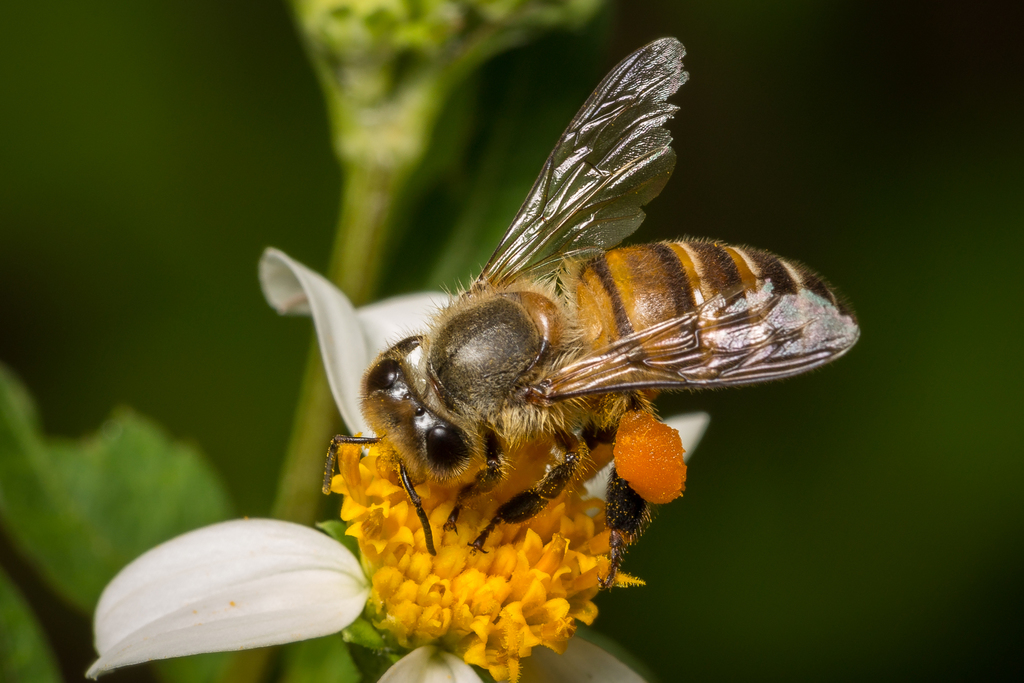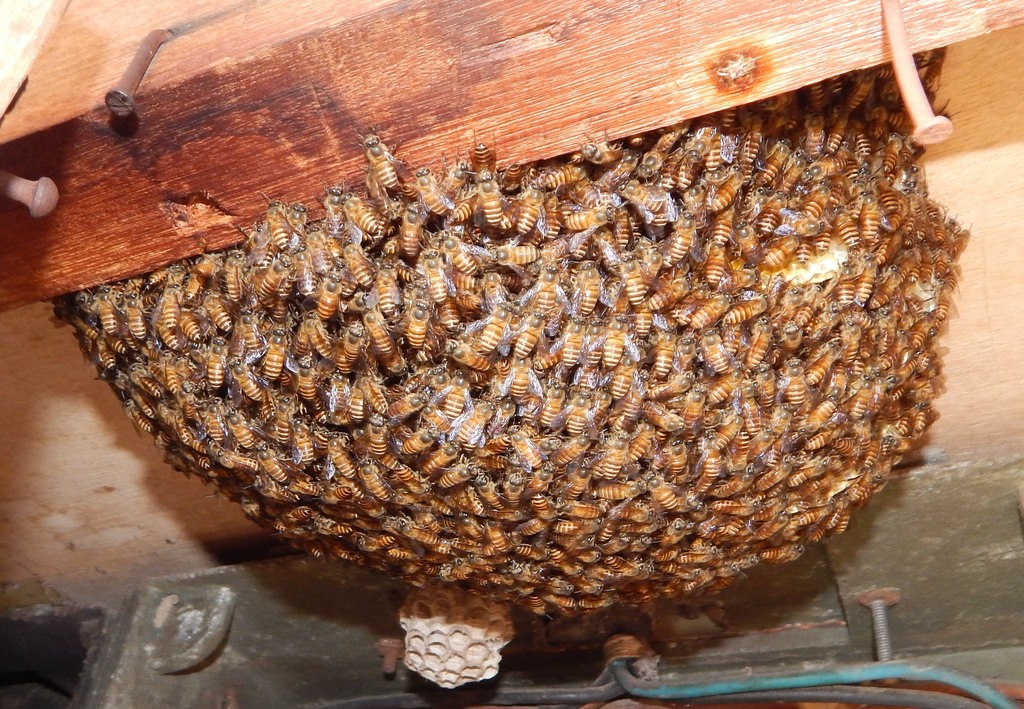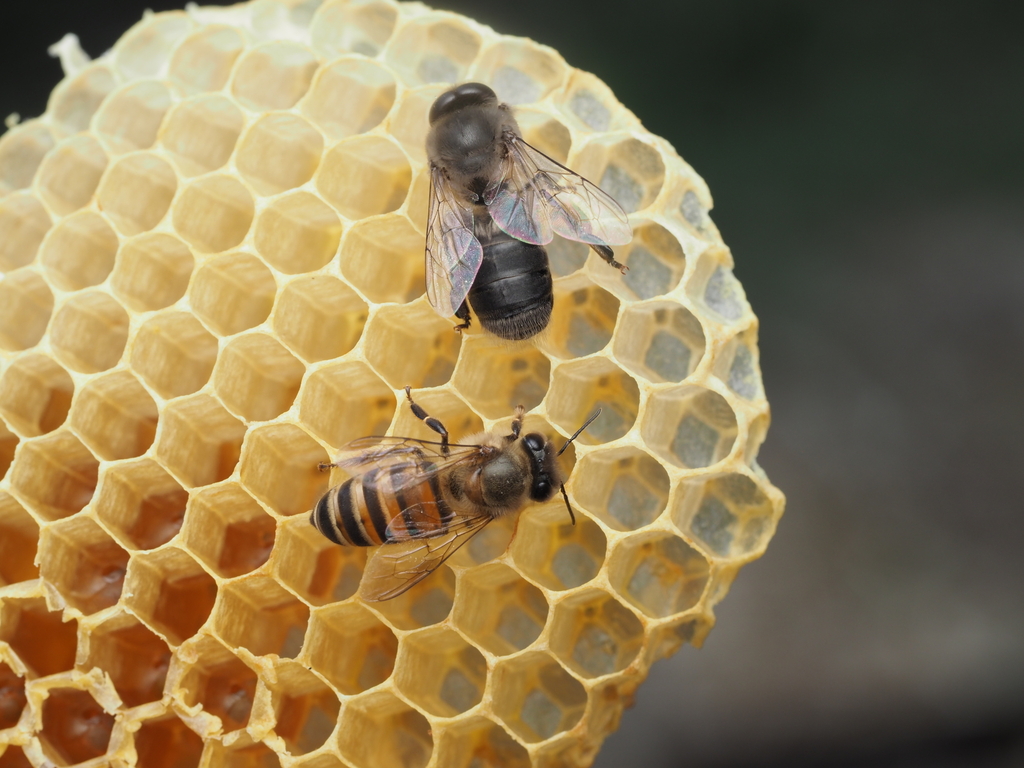ເລກລຳດັບທີ: 894
ລະດັບການຮວບຮວມຂໍ້ມູນ: ຂໍ້ມູນພື້ນຖານ
ປັບປູງຄັ້ງລ່າສຸດ: 2025-11-17
ເຜິ້ງໂກນ
Honey Bee
Apis cerana Fabricius, 1793
ສັດ
ສັດທີ່ມີຂໍ້ຕໍ່
ແມງໄມ້
×
ຊື່ທ້ອງຖີ່ນ:
( Asian Honeybee)
ຊື່ພ້ອງ
:
Apis ceran subsp. cathayca Zhang, 1989
Apis cerana subsp. abaensis Hepburn, Smith, Radloff & Otis, 2001
Apis cerana subsp. abansis Yang & Kuang, 1986
Apis cerana subsp. bijieca Zhuang, 1989
Apis cerana subsp. cathayca Zuang, 1989
Apis cerana subsp. hainana Yang & Kuang, 1986
Apis cerana subsp. hainanensis Hepburn, Smith, Radloff & Otis, 2001
Apis cerana subsp. heimifeng Engel, 1999
Apis cerana subsp. indica Fabricius, 1798
Apis cerana subsp. japonica Radoszkowski, 1887
Apis cerana subsp. javana Enderlein, 1906
Apis cerana subsp. johni Skorikov, 1929
Apis cerana subsp. kweiyanga Zhuang, 1989
Apis cerana subsp. nuluensis Tingek, Koeniger & Koeniger, 1996
Apis cerana subsp. pekinga Zhuang, 1989
Apis cerana subsp. shangkianga Zhuang, 1989
Apis cerana subsp. twolakeca Zhuang, 1989
Apis delesserti Buttel-Reepen, 1906
Apis delessertii Guérin-Méneville, 1844
Apis gronovii Le Guillou, 1841
Apis indica Fabricius, 1798
Apis indica subsp. javana Enderlein, 1906
Apis indica subsp. philippina Skorikov, 1929
Apis johni Skorikov, 1929
Apis lieftincki Maa, 1953
Apis mellifica subsp. japonica Radoszkowski, 1887
Apis nuluensis Tingek, Koeniger & Koeniger, 1996
Apis peroni Latreille, 1804
Apis perrottetii Guérin-Méneville, 1845
Apis samarensis Maa, 1953
Apis sinensis Smith, 1865
Apis socialis Latreille, 1804
Apis cerana subsp. abaensis Hepburn, Smith, Radloff & Otis, 2001
Apis cerana subsp. abansis Yang & Kuang, 1986
Apis cerana subsp. bijieca Zhuang, 1989
Apis cerana subsp. cathayca Zuang, 1989
Apis cerana subsp. hainana Yang & Kuang, 1986
Apis cerana subsp. hainanensis Hepburn, Smith, Radloff & Otis, 2001
Apis cerana subsp. heimifeng Engel, 1999
Apis cerana subsp. indica Fabricius, 1798
Apis cerana subsp. japonica Radoszkowski, 1887
Apis cerana subsp. javana Enderlein, 1906
Apis cerana subsp. johni Skorikov, 1929
Apis cerana subsp. kweiyanga Zhuang, 1989
Apis cerana subsp. nuluensis Tingek, Koeniger & Koeniger, 1996
Apis cerana subsp. pekinga Zhuang, 1989
Apis cerana subsp. shangkianga Zhuang, 1989
Apis cerana subsp. twolakeca Zhuang, 1989
Apis delesserti Buttel-Reepen, 1906
Apis delessertii Guérin-Méneville, 1844
Apis gronovii Le Guillou, 1841
Apis indica Fabricius, 1798
Apis indica subsp. javana Enderlein, 1906
Apis indica subsp. philippina Skorikov, 1929
Apis johni Skorikov, 1929
Apis lieftincki Maa, 1953
Apis mellifica subsp. japonica Radoszkowski, 1887
Apis nuluensis Tingek, Koeniger & Koeniger, 1996
Apis peroni Latreille, 1804
Apis perrottetii Guérin-Méneville, 1845
Apis samarensis Maa, 1953
Apis sinensis Smith, 1865
Apis socialis Latreille, 1804
ຊື່ສະກຸນ:
Apidae
ຊະນິດໃກ້ຄຽງ:
ເຜິ້ງມິ້ມ/ Little Bee
ເຜິ້ງຫຼວງ/ Giant Honey Bee
ເຜິ້ງຫຼວງ/ Giant Honey Bee
ບັນຍາຍລັກສະນະທາງພືດສາດ:
ເຜິ້ງໂກນ ຕົວເຕັມໄວມີຄວາມຍາວປະມານ 10 ມມ, ປີກຄູ່ໜ້າມີຂະໜາດ 7.4 ຫາ 9 ມມ, ລຳຕົວສ່ວນໃຫຍ່ເປັນສີດຳ, ມີແຖບສີເຫຼືອງ ສີແຖບບໍລິເວນທ້ອງ ແລະ ສີນ້ຳຕານ.
ເຜິ້ງຈະມີໜາມ 10 ອັນ ໃນເຂັ້ມທີ່ໃຊ້ປັກ ແລະ ໜາມ 4 ຫາ 5 ຄູ່ເທິງສະໄຕເລ໊ຕ ໄລຍະຫາງຈາກປາຍເຂັມ ຍາວ 49.87 ໄມໂຄແມັດ.
ເຜິ້ງງານຍັງມີອຸປະກອນເກັບເກສອນທີບໍລິເວນຂາຫຼັງ ເຊິ່ງພວກມັນໃຊ້ໃນການຮວບຮວມ ແລະ ຂົນສົ່ງເກສອນທີ່ໜ້າສົນໃຈ ຄືກັນກັບທີ່ຂະໜາດລຳຕົວແຕກຕ່າງກັນໄປຕາມແຕ່ລະພື້ນທີ່ ຂະໜາດຂອງຈຸລັງເຜິ້ງງານກໍ່ແຕກຕ່າງກັນ.
ລັກສະນະຂອງຮັງ: ໂດຍທົ່ວໄປແລ້ວເຜິ້ງໂກນຈະສ້າງຮັງແບບຮວງເຜິ້ງຫຼາຍຮັງ ພາຍໃນໂພງມືດ, ເຖິ່ງແມ່ນວ່າຈະພົບຮັງແບບເປີດ ເຊັ່ນ: ຮັງທີ່ສ້າງໃຕ້ຊາຍຄາຂອງອາຄານ, ຮັງເຜິ້ງຈະຈັບຂະໜານກັນ ໂດຍຮັກສາໄລ່ຍະຫ່າງໃຫ້ຄົງທີ, ນ້ຳເຜິ້ງຈະຈັບຢູ່ສ່ວນເທິງຂອງຮວງເຜິ້ງ ແລະ ຕາມຮວງເຜິ້ງດ້ານນອກທີ່ຕິດຕັ້ງກັບພະໜັງໂພງ ໃນຂະນະທີ່ບໍລິເວນກາງຈະມີຕົວອ່ອນໃນໄລຍະພັດທະນາການຕ່າງຢູ່.
ພຶດຕິກຳ: ໂດຍທົ່ວໄປແລ້ວເຜິ້ງໂກນ ຈະບໍ່ຮ້າຍ, ອ່ອນໂຍນ, ອົດທົນ ແລະ ຂີ້ອາຍ, ມີນິໄສອ່ອນໂຍນ, ບໍ່ຄ່ອຍມັກກັດ, ເຖິ່ງຢ່າງໃດກໍ່ຕາມມັນຈະກັດເມື່ອຖືກລົບກວນ, ຖືກຕ້ອນ ຫຼື ຖືກລົບກວນຢ່າງຮຸນແຮງ.
ການປະສົມພັນ ແລະ ການສືບພັນ: ເຜິ້ງໂກນມີລັກສະນະການສືບພັນທີ່ໂດດເດັ່ນຫຼາຍຢ່າງ, ເຜິ້ງຕົວຜູ້ຈະແຂງກັນປະສົມພັນກັບເຜິ້ງລາຊີນີແຕ່ລະຕົວ ແລະ ເຜິ້ງຕົວຜູ້ຈະຕາຍຫຼັງຈາກປະສົມພັນບໍ່ດົນ. ໂດຍທົ່ວໄປແລ້ວເຜິ້ງລາຊີນີຈະປະສົມພັນກັບເຜິ້ງຕົວຜູ້ຫຼາຍຕົວລະຫວ່າງການບິນ, ໂດຍການປະສົມພັນຈະເກີດຂື້ນກາງອາກາດ ຢູ່ໃນພື້ນທີ່ສະເພາະທີ່ເອີ້ນວ່າ ພື້ນທີ່ລວມຕົວຂອງເຜິ້ງຕົວຜູ້. ລະດູປະສົມພັນຂອງເຜິ້ງສະກຸນນີ້ ຈະໃກ້ຊິດກັບກັບກິດຈະກຳການແຕກຝູງ ແລະ ວົງຈອນການອອກດອກຕາມລະດູການ, ສົ່ງຜົນໃຫ້ເຜິ້ງສະກຸນນີ້ຕ່າງຊະນິດກັນສືບພັນພ້ອມກັນໃນຫຼາຍພູມີພາກ ເຊິ່ງອາດນຳໄປສູ່ພາວະການສືບພັນທີ່ທັບຊ້ອນ.
ພັດທະນາການ: ຂອງເຜິ້ງງານໃນຮັງເຜິ້ງເປັນໄປຕາມຮູບແບບການປ່ຽນແປງຮູບຮ່າງຢ່າງສົມບູນທີ່ສາມາດພົບໄດ້ໃນແມງໄມ້ຊະນິດອື່ນ, ເຊິ່ງປະກອບດ້ວຍ 4 ໄລ່ຍະ ໄດ້ແກ່ ໄຂ່, ຕົວອ່ອນ, ດັກແດ້ ແລະ ຕົວເຕັມໄວ, ຕົວອ່ອນຈະຈະເລີນເຕີບໂຕ ປະມານ 3 ວັນ ໂດຍໄດ້ຮັບສານອາຫານຈາກໄຂ່ແດງທີ່ອຸດົມໄປດ້ວຍໂປຣຕີນ ຕໍ່ດ້ວຍໄລ່ຍະຕົວອ່ອນຈະກິນນ້ຳເຜິ້ງ, ເກສອນດອກໄມ້ ແລະ ອາຫານຈາກເຜິ້ງຕົວເຕັມໄວ ໃນທີ່ສຸດຕົວອ່ອນຈະປັ່ນຂີ້ເຜິ້ງ ເຂົ້າສູ່ໄລ່ຍະດັກແດ້ ແລະ ຈະເລີນເຕີບໂຕເຕັມທີກ່ອນທີ່ຈະກັດແທະເປືອກໄຂເຜິ້ງ ຈົນກາຍເປັນຕົວເຕັມໄວ.
ການໃຫ້ອາຫານ: ເຜິ້ງງານຕົວເຕັມໄວຈະກິນລະອອງເກສອນ ແລະ ນ້ຳຫວານ ຫຼື ນ້ຳເຜິ້ງເປັນຫຼັກ, ເຖິງແມ່ນວ່າຄຸນຄ່າທາງດ້ານໂພຊະນາການຂອງລະອງເກສອນຈະແຕກຕ່າງກັນໄປຂື້ນກັບແຫຼ່ງທີ່ມາຂອງພືດ. ລະອອງເກສອນປະສົມເຮັດໃຫ້ຄຸນຄ່າທາງດ້ານໂພຊະນາການສູງ ໃຫ້ສານອາຫານທີ່ຈຳເປັນຕໍ່ການຈະເລີນເຕີບໂຕຂອງເຜິ້ງອ່ອນ. ຢ່າງໃດກໍ່ຕາມ ເມື່ອລະອອ່ອງເກສອນແຫ້ງຈະສູນເສຍຄຸນຄ່າທາງດ້ານໂພຊະນາການຢ່າງໄວ, ນອກຈາກການກິນອາຫານເອງແລ້ວ ເຜິ້ງຍັງມີຂະບວນການຫາອາຫານຮ່ວມກັນຜ່ານຂະບວນການທີ່ເອີ້ນວ່າ “ການຖ່າຍທອດອາຫານ” ເຜິ້ງງານອາດໄດ້ຮັບອາຫານໂດຍຕົງຈາກຣາຊະນີ ໃນຂະນະທີ່ເຜິ້ງຕົວຜູ້ໄດ້ຮັບອາຫານໂດຍການກິນສິ່ງທີ່ເຜິ້ງຕົວອື່ນຮາກອອກມາ ເຜິ້ງງານຈະໄດ້ຮັບອາຫານຕົວອ່ອນຈາກເຜິ້ງງານໃນລະດູໜາວ ດັງນັ້ນເຜິ້ງງານຈຶ່ງບໍ່ກິນນ້ຳເຜິ້ງ ຫຼື ໄດ້ຮັບນ້ຳເຜິ້ງເປັນອາຫານ.
ແຫຼ່ງທີ່ມາ: [1], [2]
ເຜິ້ງຈະມີໜາມ 10 ອັນ ໃນເຂັ້ມທີ່ໃຊ້ປັກ ແລະ ໜາມ 4 ຫາ 5 ຄູ່ເທິງສະໄຕເລ໊ຕ ໄລຍະຫາງຈາກປາຍເຂັມ ຍາວ 49.87 ໄມໂຄແມັດ.
ເຜິ້ງງານຍັງມີອຸປະກອນເກັບເກສອນທີບໍລິເວນຂາຫຼັງ ເຊິ່ງພວກມັນໃຊ້ໃນການຮວບຮວມ ແລະ ຂົນສົ່ງເກສອນທີ່ໜ້າສົນໃຈ ຄືກັນກັບທີ່ຂະໜາດລຳຕົວແຕກຕ່າງກັນໄປຕາມແຕ່ລະພື້ນທີ່ ຂະໜາດຂອງຈຸລັງເຜິ້ງງານກໍ່ແຕກຕ່າງກັນ.
ລັກສະນະຂອງຮັງ: ໂດຍທົ່ວໄປແລ້ວເຜິ້ງໂກນຈະສ້າງຮັງແບບຮວງເຜິ້ງຫຼາຍຮັງ ພາຍໃນໂພງມືດ, ເຖິ່ງແມ່ນວ່າຈະພົບຮັງແບບເປີດ ເຊັ່ນ: ຮັງທີ່ສ້າງໃຕ້ຊາຍຄາຂອງອາຄານ, ຮັງເຜິ້ງຈະຈັບຂະໜານກັນ ໂດຍຮັກສາໄລ່ຍະຫ່າງໃຫ້ຄົງທີ, ນ້ຳເຜິ້ງຈະຈັບຢູ່ສ່ວນເທິງຂອງຮວງເຜິ້ງ ແລະ ຕາມຮວງເຜິ້ງດ້ານນອກທີ່ຕິດຕັ້ງກັບພະໜັງໂພງ ໃນຂະນະທີ່ບໍລິເວນກາງຈະມີຕົວອ່ອນໃນໄລຍະພັດທະນາການຕ່າງຢູ່.
ພຶດຕິກຳ: ໂດຍທົ່ວໄປແລ້ວເຜິ້ງໂກນ ຈະບໍ່ຮ້າຍ, ອ່ອນໂຍນ, ອົດທົນ ແລະ ຂີ້ອາຍ, ມີນິໄສອ່ອນໂຍນ, ບໍ່ຄ່ອຍມັກກັດ, ເຖິ່ງຢ່າງໃດກໍ່ຕາມມັນຈະກັດເມື່ອຖືກລົບກວນ, ຖືກຕ້ອນ ຫຼື ຖືກລົບກວນຢ່າງຮຸນແຮງ.
ການປະສົມພັນ ແລະ ການສືບພັນ: ເຜິ້ງໂກນມີລັກສະນະການສືບພັນທີ່ໂດດເດັ່ນຫຼາຍຢ່າງ, ເຜິ້ງຕົວຜູ້ຈະແຂງກັນປະສົມພັນກັບເຜິ້ງລາຊີນີແຕ່ລະຕົວ ແລະ ເຜິ້ງຕົວຜູ້ຈະຕາຍຫຼັງຈາກປະສົມພັນບໍ່ດົນ. ໂດຍທົ່ວໄປແລ້ວເຜິ້ງລາຊີນີຈະປະສົມພັນກັບເຜິ້ງຕົວຜູ້ຫຼາຍຕົວລະຫວ່າງການບິນ, ໂດຍການປະສົມພັນຈະເກີດຂື້ນກາງອາກາດ ຢູ່ໃນພື້ນທີ່ສະເພາະທີ່ເອີ້ນວ່າ ພື້ນທີ່ລວມຕົວຂອງເຜິ້ງຕົວຜູ້. ລະດູປະສົມພັນຂອງເຜິ້ງສະກຸນນີ້ ຈະໃກ້ຊິດກັບກັບກິດຈະກຳການແຕກຝູງ ແລະ ວົງຈອນການອອກດອກຕາມລະດູການ, ສົ່ງຜົນໃຫ້ເຜິ້ງສະກຸນນີ້ຕ່າງຊະນິດກັນສືບພັນພ້ອມກັນໃນຫຼາຍພູມີພາກ ເຊິ່ງອາດນຳໄປສູ່ພາວະການສືບພັນທີ່ທັບຊ້ອນ.
ພັດທະນາການ: ຂອງເຜິ້ງງານໃນຮັງເຜິ້ງເປັນໄປຕາມຮູບແບບການປ່ຽນແປງຮູບຮ່າງຢ່າງສົມບູນທີ່ສາມາດພົບໄດ້ໃນແມງໄມ້ຊະນິດອື່ນ, ເຊິ່ງປະກອບດ້ວຍ 4 ໄລ່ຍະ ໄດ້ແກ່ ໄຂ່, ຕົວອ່ອນ, ດັກແດ້ ແລະ ຕົວເຕັມໄວ, ຕົວອ່ອນຈະຈະເລີນເຕີບໂຕ ປະມານ 3 ວັນ ໂດຍໄດ້ຮັບສານອາຫານຈາກໄຂ່ແດງທີ່ອຸດົມໄປດ້ວຍໂປຣຕີນ ຕໍ່ດ້ວຍໄລ່ຍະຕົວອ່ອນຈະກິນນ້ຳເຜິ້ງ, ເກສອນດອກໄມ້ ແລະ ອາຫານຈາກເຜິ້ງຕົວເຕັມໄວ ໃນທີ່ສຸດຕົວອ່ອນຈະປັ່ນຂີ້ເຜິ້ງ ເຂົ້າສູ່ໄລ່ຍະດັກແດ້ ແລະ ຈະເລີນເຕີບໂຕເຕັມທີກ່ອນທີ່ຈະກັດແທະເປືອກໄຂເຜິ້ງ ຈົນກາຍເປັນຕົວເຕັມໄວ.
ການໃຫ້ອາຫານ: ເຜິ້ງງານຕົວເຕັມໄວຈະກິນລະອອງເກສອນ ແລະ ນ້ຳຫວານ ຫຼື ນ້ຳເຜິ້ງເປັນຫຼັກ, ເຖິງແມ່ນວ່າຄຸນຄ່າທາງດ້ານໂພຊະນາການຂອງລະອງເກສອນຈະແຕກຕ່າງກັນໄປຂື້ນກັບແຫຼ່ງທີ່ມາຂອງພືດ. ລະອອງເກສອນປະສົມເຮັດໃຫ້ຄຸນຄ່າທາງດ້ານໂພຊະນາການສູງ ໃຫ້ສານອາຫານທີ່ຈຳເປັນຕໍ່ການຈະເລີນເຕີບໂຕຂອງເຜິ້ງອ່ອນ. ຢ່າງໃດກໍ່ຕາມ ເມື່ອລະອອ່ອງເກສອນແຫ້ງຈະສູນເສຍຄຸນຄ່າທາງດ້ານໂພຊະນາການຢ່າງໄວ, ນອກຈາກການກິນອາຫານເອງແລ້ວ ເຜິ້ງຍັງມີຂະບວນການຫາອາຫານຮ່ວມກັນຜ່ານຂະບວນການທີ່ເອີ້ນວ່າ “ການຖ່າຍທອດອາຫານ” ເຜິ້ງງານອາດໄດ້ຮັບອາຫານໂດຍຕົງຈາກຣາຊະນີ ໃນຂະນະທີ່ເຜິ້ງຕົວຜູ້ໄດ້ຮັບອາຫານໂດຍການກິນສິ່ງທີ່ເຜິ້ງຕົວອື່ນຮາກອອກມາ ເຜິ້ງງານຈະໄດ້ຮັບອາຫານຕົວອ່ອນຈາກເຜິ້ງງານໃນລະດູໜາວ ດັງນັ້ນເຜິ້ງງານຈຶ່ງບໍ່ກິນນ້ຳເຜິ້ງ ຫຼື ໄດ້ຮັບນ້ຳເຜິ້ງເປັນອາຫານ.
ແຫຼ່ງທີ່ມາ: [1], [2]
ນິເວດວິທະຍາ
ເຂດກະຈາຍພັນທົ່ວໂລກ:
Native to include Afghanistan, Bangladesh, Bhutan, Brunei, Cambodia, China, India, Indonesia, Japan, Laos, Malaysia, Myanmar, Nepal, North Korea, Pakistan, the Philippines, Russia, South Korea, Sri Lanka, Taiwan, Thailand, Timor-Leste, and Vietnam. [3]
Global distribution of Apis cerana between 1900 to 2025. Source: [4]
Global distribution of Apis cerana between 1900 to 2025. Source: [4]
ເຂດກະຈາຍພັນໃນລາວ
:
ເຂດພູສູງພາກເໜືອຂອງລາວ
ລຽບແມ່ນ້ຳຂອງພາກເໜືອ
ທົ່ງພຽງວຽງຈັນ
ເຂດສາຍພູຫຼວງຕອນລຸ່ມ
ເຂດລຽບແມ່ນ້ຳຂອງພາກໃຕ້
ພູພຽງບໍລິເວນ
ລຽບແມ່ນ້ຳຂອງພາກເໜືອ
ທົ່ງພຽງວຽງຈັນ
ເຂດສາຍພູຫຼວງຕອນລຸ່ມ
ເຂດລຽບແມ່ນ້ຳຂອງພາກໃຕ້
ພູພຽງບໍລິເວນ
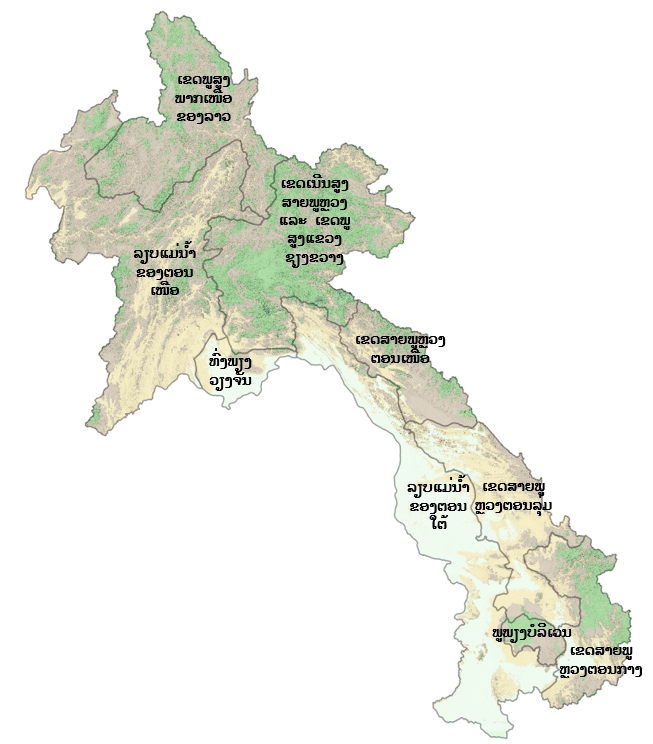
ເຂດກະຈາຍພັນຕາມພູມສັນຖານ
:
ປ່າດົງດິບ
ປ່າໂຄກ
ຜາ
ທົ່ງຫຍ້າ
ສວນຄົວ
ປ່າໂຄກ
ຜາ
ທົ່ງຫຍ້າ
ສວນຄົວ
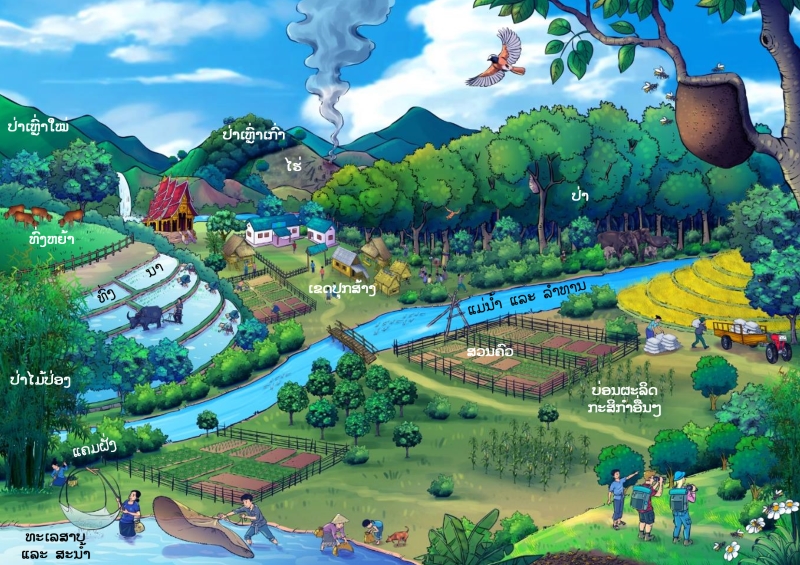
ສະເພາະຖິ່ນໃນລາວ:
ພື້ນເມືອງ
ຮຸກຮານ
:
ບໍ່ຮຸກຮານ
ສະຖານະພາບການອະນູຮັກ IUCN
:
ບໍ່ມີຄວາມສ່ຽງ
ສະຖານະພາບການອະນຸຮັກແຫ່ງຊາດລາວ
:
ບໍ່ຖືກລະບຸໃນບັນຊີປະເພດໃດ
ການນຳໃຊ້
ປະເພດການນຳໃຊ້:
ກິດຈະກຳການກະເສດ
ວັດທະນະທຳ ແລະ ຮີດຄອງ
ອາຫານ
ເຄື່ອງດື່ມ
ພືດເປັນຢາ
ເຄື່ອງສຳອາງ
ວັດທະນະທຳ ແລະ ຮີດຄອງ
ອາຫານ
ເຄື່ອງດື່ມ
ພືດເປັນຢາ
ເຄື່ອງສຳອາງ
ບັນຍາຍການນຳໃຊ້:
ອາຫານ ແລະ ເຄື່ອງດື່ມ: ນ້ຳເຜິ້ງມັກຖືກນຳມາບໍລິໂພກ ເພື່ອເປັນແຫຼ່ງພະລັງງານ. ນ້ຳຕານໂມເລກຸນດ່ຽວທີ່ຖືກດູດຊຶມເຂົ້າສູ່ກະແສເລືອດໄດ້ຢ່າງໄວໂດຍບໍ່ຕ້ອງຍ່ອຍ, ນ້ຳເຜິ້ງຍັງເປັນສານໃຫ້ຄວາມຫວານທີ່ມີປະໂຫຍດຫຼງາກຫຼາຍ ເຂົ້າກັນໄດ້ດີກັບເຄື່ອງດື່ມ ທັງຮ້ອນ ແລະ ເຢັນ ແລະ ເສີມລົດຊາດອາຫານໄດ້ເກືອບທຸກຊະນິດ, ນອກຈາກນີ້ຍັງມີຄຸນສົມບັດໃນການກັກເກັບຊຸ່ມ ແລະະ ຍັງຊ່ວຍຮັກສາກັກເກັບຄວາມສົດຂອງເຂົ້າໜົມປັງ, ເຄັກ, ຄຸກກີ້ ແລະ ເຂົ້າຫວານໄດ້ດົນຂື້ນ. [7]
ສັບພະຄຸນທາງສະໝຸນໄພ:
ນ້ຳເຜິ້ງເປັນສານສະໝານແຜ່ທີ່ເກົ່າແກ່ທີ່ສຸດທີ່ມະນຸດຮູ້ຈັກ, ການສຶກສາໃນຫ້ອງທົດລອງໄດ້ໃຫ້ຫຼັກຖານທີ່ສະໜັບສະໜຸນປະສິດທິພາບໃນການຮັກສາແຜທີ່ເພີ່ມຂື້ນ, ເນື່ອງຈາກນ້ຳເຜິ້ງມີປະສິດທິພາບທາງຊິວະພາບທີ່ຫຼາກຫຼາຍ ໄດ້ແກ່ ມີລິດຕ້ານເຊື້ອແບັກທິເຣຍ, ຕ້ານໄວຣັສ, ຕ້ານການອັກເສບ ແລະ ຕ້ານອານຸມູນອິດສະຫຼະ. ນອກຈາກນນີ້ນ້ຳເຜິ້ງຍັງຊ່ວຍກະຕຸ້ນການຕອບສະໜອງຂອງລະບົບພູມຄຸ້ມກັນຕໍ່ການຕິດເຊື້ອ ແລະ ຍັງມີລາຍງານເຖິງລິດໃນການປັບພູມຄຸ້ມກັນ ເພີ່ມອີກດ້ວຍ. ການຄົ້ນຄວ້າໄດ້ສະແດງໃຫ້ເຫັນບົດບາດຂອງນ້ຳເຜິ້ງທຳມະຊາດໃນຂະບວນການສະລໍໄວຫຼາຍປະການ ເຊິ່ງສ່ວນໃຫຍ່ຈະເປັນຜົນມາຈາກສານປະກອບທີ່ອອກລິດທາງຊີວະພາບທີ່ມີປະຕິກິລິຍາສູງ. [5]
ມີຫຼັກຖານທີ່ຊັດເຈນໃນການບົ່ງຊີ້ເຖິງຜົນປະໂຫຍດຂອງນ້ຳເຜິ້ງໃນການຊ່ວຍຈັດການພະຍາດເບົາຫວານ ໃນຜູປ່ວຍໂຣກເບົາຫວານ. ນ້ຳເຜິ້ງໄດ້ຮັບການພິສູດແລ້ວວ່າ ຊ່ວຍບຫຼຸດລະດັບນ້ຳຕານຄຼູໂຄສໃນາສມາໄດ້ຢ່າງມີໄນສຳຄັນກັບ dextran. ທັງໃນຜູ້ທີ່ມີສຸຂະພາບແຂງແຮງ ແລະ ຜູ້ທີ່ມີພາວະໄຂມັນໃນເລືອດສູງ ນ້ຳເຜິ້ງຍັງຊ່ວຍຫຼຸດລະດັບໄຂມັນໃນເລືອດ ໂຮໂມຊິສເທອິນ ແລະ ຄວາມເຂັ້ມຂຸ້ນຂອງໂປຣຕີນຊີລີແອັກທິບ. [5]
ນ້ຳເຜິ້ງ ແລະ ຄຸນສົມບັດຕ້ານມະເຣັງ: ການຄົ້ນຄວ້າວິໄຈ ສະແດງໃຫ້ເຫັນວ່ານ້ຳເຜິ້ງມີລິດຕ້ານມະເຣັງ ຜ່ານຂະບວນການຕ້ານການກາຍພັນ, ຕ້ານການເພີ່ມຈຳນວນ ແລະ ຕ້ານການອັກເສບ, ນ້ຳເຜິ້ງສາມາດຢັບຢັ້ງການເພີ່ມຈຳນວນຂອງຈຸລັງ ກະຕຸ້ນການຕາຍຂອງຈຸລັງ, ປ່ຽນແປງການດຳເນີນວັດນນະຈັກຂອງຈຸລັງ ແລະ ເຮັດໃຫເກີດພາວະ depolarization ຂອງແຜຫຸ້ມໄມໂທຄອນເດຼຍໃນມະເຣັງຫຼາຍຊະນິດ ໄດ້ແກ່ມະເຣັງໂນມາ, ແຜຈຸລັງອະດີໂນຄາຊີໂນມາ, ມະເຣັງປາກມົດລູກ, ມະເຣັງເຫຍື່ອບຸປາກມົດລູກ, ມະເຣັງຕັບ, ມະເຮັງລຳໄສ້ໃຫຍ່ ແລະ ທະວານໜັກ, ມະເຣັງຕ່ອມລູກໝາກ, ມະເຣັງໝາກໄຂ່ຫຼັງ, ມະເຣັງກະເພາະປັດສະວະ, ມະເຣັງປອດຊະນິດທີ່ໍ່ແມ່ນມະເຣັງຂະໜາດນ້ອຍ, ມະເຣັງກະດູກຊະນິດອອສທີໂອຊາສໂຄມາ, ມະເຣັງເມັດເລືອດຂາວ ແລະ ມະເຣັງຈຸລັງສຄວາມັສຊະນິດຊ່ອງປາກ, ນອກຈາກນີ້ຍັງມີລາຍງານວ່ານ້ຳເຜິ້ງສາາດຢັບຢັ້ງການເຕີບໂຕຂອງເນື້ອງອກຫຼາຍຊະນິດ. [5]
ນ້ຳເຜິ້ງຖູກນຳມາໃຊ້ເປັນສະໝຸນໄພພື້ນບ້ານເພື່ອໃຊ້ຮັກສາອາການອັກເສບ, ໄອ ແລະ ມີໄຂ້ເປັນເວລາດົນ, ງານການຄົ້ນຄວ້າໄດ້ສະແດງໃຫ້ເຫັນເຖິງຄວາມສາມາດໃນການຫຼຸດອາການທີ່ກ່ຽວຂ້ອງກັບພະຍາດຫອບຫືດ ແລະ ເຮັດໜ້າທີ່ເປັນສານປ້ອງກັນການເກີດພະຍາດຫອບຫືດ, ນອດຈາກນີ້ຍັງມີລາຍງານວ່າ ການກິນນ້ຳເຜິີ້ງຈະຊ່າຍບັນເທົາອາການຫຼອດລົມອັກເສບຊຳເຮຶ້ອ ແລະ ພະຍາດຫອບຫືດໄດ້ອີກດ້ວຍ. [5]
ສານຕ້ານອານຸມູນອິດສະຫຼະທີ່ມີຢູ່ໃນນ້ຳເຜິ້ງ ເຊັ່ນ ຟາໂວນອຍ, ໂພລີຟີນອລ, ວິຕາມິນຊີ ແລະ ໂມໂນຟິລນອລ ອາດກ່ຽວຂ້ອງກັບຄວາມສ່ຽງຕໍ່ພະຍາດຫົວໃຈ ແລະ ຫຼອດເລືອດໃຫ້ຫຼຸດລົງ, ໃນພະຍາດຫຼອດເລືອຫົວໃຈ ເຊື່ອກັນວ່າ ນ້ຳເຜິ້ງມີລິດປ້ອງກັນຜ່ານກົນໄກຫຼັກ 3 ປະການໄດ້ແກ່: ກະຕຸ້ນການຂະຫຍາຍຫຼອດເລືອດຫົວໃຈ, ຫຼຸດການເກາະກຸ່ມ ແລະ ການເກືດຫຼິ່ມເລືອດຂອງເກັດເລືອດ ແລະ ຍັງຢັບຢັ້ງການເກີດອອັກຊີເດຊິນຂອງໄລໂປໂປຣຕີນຄວາມໜາແໜ້ນຕ່ຳ. [5]
ນ້ຳເຜິ້ງມີຫຼິດຊ່ວຍຫຼຸດຄວາມວິຕົກກັງວົນ, ຕ້ານອາການຊຶມເສົ້າ, ຕ້ານອາການຊັກ ແລະ ຕ້ານການຫຼັ່ງສານສື່ປະສາດ ໃນຄະນະດຽວກັນກໍ່ຊ່ວຍຫຼຸດຄວາມຄຽດ ອອກຊີເດເຊິນໃນລະບບົປະສາດສ່ວນກາງ, ການຄົ້ນຄວ້າຫຼາຍສະບັບຊີ້ໃຫ້ເຫັນວ່າໂຟລີຟີນອລໃນນ້ຳເຜິ້ງມີຄຸນສົມບັດໂນໂອໂທນປິກ ແລະ ປົກປ້ອງລະບົບປະສາດ ຊຶ່ງຊ່ວຍສະໜັບສະໜຸນການທຳງານຂອງລະບົບຮັບຮູ້ ແລະ ປົກປ້ອງເນື້ອເຫຍື້ອປະສາດ. [5]
ມີຂໍ້ສະເໜີແນະວ່ານ້ຳເຜິ້ງອາດຈະມີປະໂຫຍດຕໍ່ສຸຂະພາບຕ່າງໆ ຂອງລະບົບທາງເດີນອາຫານລວມທັງໂຣປີທັນ ແລະ ພະຍາດໃນຊ່ອງປາກອື່ນໆ, ອາການອາຫານບໍ່ຍ່ອຍ ແລະ ເປັນສ່ວນປະກອບຂອງການບຳບັດໂດຍການໃຫ້ເກື່ອແຮ່ທາງປາກ ຈາການສັງເກດທາງຄີນິກພົບວ່ານ້ຳເຜິ້ງມີລິດໃນການບຳບັດຮັກສາເດັກນ້ອຍ ແລະ ເດກັນ້ອຍທີ່ເຂົ້າຮັບການຮັກສາໃນໂຮງໝໍ ທີ່ເກີດຈາກພະຍາດກະເພາະ ແລະ ລຳໄສ້ອັກເສສບ ໂດຍຊ່ວຍຫຼຸດໄລ່ຍະເວລາຂອງອາການຖອກທ້ອງໃນຜູ້ປ່ອຍທີ່ໄດ້ຮັບນ້ຳເຜິ້ງໄດ້ຢ່າງມີໄນສຳຄັນ. [5]
ກິດຈະກຳທາງການກະເສດ: ສາມາດສົ່ງເສີມເຜິ້ງໃຫ້ເປັນປັດໄຈການຜະລິດທາງການກະເສດທີ່ສຳຄັນໄດ້ໂດຍການໃຊ້ປະໂຫຍດຈາກເຜິ້ງຢ່າງມີປະສິດທິພາບໃນການຈັດການ ຫຼື ຄວບຄຸມການປະສົມເກສອນໃນການກະເສດ. [8]
ວັດທະນະທຳ ແລະ ເຄື່ອງສຳອາງ: ຂີ້ເຜິ້ງຖືກນຳມາໃຊ້ເປັນຈຳນວນຫຼາຍໃນການຜະລິດທຽນໄຂ, ຂັດເງົາ, ເຄື່ອງສຳອາງ ແລະ ການໃຊ້ງານທາງການແພດ, ນອກຈາກນີ້ຍັງສາມາດນຳໄປແປຮູບເປັນແຜ່ນຂີ້ເຜິ້ງໄດ້ອີກດ້ວຍ ໃນອຸດສາຫະກຳຢາ, ຂີ້ເຜິ້ງຖູກນຳໄປປະສົມໃນຂີ້ເຜິ້ງຊະນິດຕ່າງໆ ໃຊ້ເຄືອບເມັດ ແລະ ຢາເໜັບ ແລະຍັງໃຊ້ໃນຜະລິດຕະພັນອື່ນໆ. [9]
ສັບພະຄຸນທາງສະໝຸນໄພ:
ນ້ຳເຜິ້ງເປັນສານສະໝານແຜ່ທີ່ເກົ່າແກ່ທີ່ສຸດທີ່ມະນຸດຮູ້ຈັກ, ການສຶກສາໃນຫ້ອງທົດລອງໄດ້ໃຫ້ຫຼັກຖານທີ່ສະໜັບສະໜຸນປະສິດທິພາບໃນການຮັກສາແຜທີ່ເພີ່ມຂື້ນ, ເນື່ອງຈາກນ້ຳເຜິ້ງມີປະສິດທິພາບທາງຊິວະພາບທີ່ຫຼາກຫຼາຍ ໄດ້ແກ່ ມີລິດຕ້ານເຊື້ອແບັກທິເຣຍ, ຕ້ານໄວຣັສ, ຕ້ານການອັກເສບ ແລະ ຕ້ານອານຸມູນອິດສະຫຼະ. ນອກຈາກນນີ້ນ້ຳເຜິ້ງຍັງຊ່ວຍກະຕຸ້ນການຕອບສະໜອງຂອງລະບົບພູມຄຸ້ມກັນຕໍ່ການຕິດເຊື້ອ ແລະ ຍັງມີລາຍງານເຖິງລິດໃນການປັບພູມຄຸ້ມກັນ ເພີ່ມອີກດ້ວຍ. ການຄົ້ນຄວ້າໄດ້ສະແດງໃຫ້ເຫັນບົດບາດຂອງນ້ຳເຜິ້ງທຳມະຊາດໃນຂະບວນການສະລໍໄວຫຼາຍປະການ ເຊິ່ງສ່ວນໃຫຍ່ຈະເປັນຜົນມາຈາກສານປະກອບທີ່ອອກລິດທາງຊີວະພາບທີ່ມີປະຕິກິລິຍາສູງ. [5]
ມີຫຼັກຖານທີ່ຊັດເຈນໃນການບົ່ງຊີ້ເຖິງຜົນປະໂຫຍດຂອງນ້ຳເຜິ້ງໃນການຊ່ວຍຈັດການພະຍາດເບົາຫວານ ໃນຜູປ່ວຍໂຣກເບົາຫວານ. ນ້ຳເຜິ້ງໄດ້ຮັບການພິສູດແລ້ວວ່າ ຊ່ວຍບຫຼຸດລະດັບນ້ຳຕານຄຼູໂຄສໃນາສມາໄດ້ຢ່າງມີໄນສຳຄັນກັບ dextran. ທັງໃນຜູ້ທີ່ມີສຸຂະພາບແຂງແຮງ ແລະ ຜູ້ທີ່ມີພາວະໄຂມັນໃນເລືອດສູງ ນ້ຳເຜິ້ງຍັງຊ່ວຍຫຼຸດລະດັບໄຂມັນໃນເລືອດ ໂຮໂມຊິສເທອິນ ແລະ ຄວາມເຂັ້ມຂຸ້ນຂອງໂປຣຕີນຊີລີແອັກທິບ. [5]
ນ້ຳເຜິ້ງ ແລະ ຄຸນສົມບັດຕ້ານມະເຣັງ: ການຄົ້ນຄວ້າວິໄຈ ສະແດງໃຫ້ເຫັນວ່ານ້ຳເຜິ້ງມີລິດຕ້ານມະເຣັງ ຜ່ານຂະບວນການຕ້ານການກາຍພັນ, ຕ້ານການເພີ່ມຈຳນວນ ແລະ ຕ້ານການອັກເສບ, ນ້ຳເຜິ້ງສາມາດຢັບຢັ້ງການເພີ່ມຈຳນວນຂອງຈຸລັງ ກະຕຸ້ນການຕາຍຂອງຈຸລັງ, ປ່ຽນແປງການດຳເນີນວັດນນະຈັກຂອງຈຸລັງ ແລະ ເຮັດໃຫເກີດພາວະ depolarization ຂອງແຜຫຸ້ມໄມໂທຄອນເດຼຍໃນມະເຣັງຫຼາຍຊະນິດ ໄດ້ແກ່ມະເຣັງໂນມາ, ແຜຈຸລັງອະດີໂນຄາຊີໂນມາ, ມະເຣັງປາກມົດລູກ, ມະເຣັງເຫຍື່ອບຸປາກມົດລູກ, ມະເຣັງຕັບ, ມະເຮັງລຳໄສ້ໃຫຍ່ ແລະ ທະວານໜັກ, ມະເຣັງຕ່ອມລູກໝາກ, ມະເຣັງໝາກໄຂ່ຫຼັງ, ມະເຣັງກະເພາະປັດສະວະ, ມະເຣັງປອດຊະນິດທີ່ໍ່ແມ່ນມະເຣັງຂະໜາດນ້ອຍ, ມະເຣັງກະດູກຊະນິດອອສທີໂອຊາສໂຄມາ, ມະເຣັງເມັດເລືອດຂາວ ແລະ ມະເຣັງຈຸລັງສຄວາມັສຊະນິດຊ່ອງປາກ, ນອກຈາກນີ້ຍັງມີລາຍງານວ່ານ້ຳເຜິ້ງສາາດຢັບຢັ້ງການເຕີບໂຕຂອງເນື້ອງອກຫຼາຍຊະນິດ. [5]
ນ້ຳເຜິ້ງຖູກນຳມາໃຊ້ເປັນສະໝຸນໄພພື້ນບ້ານເພື່ອໃຊ້ຮັກສາອາການອັກເສບ, ໄອ ແລະ ມີໄຂ້ເປັນເວລາດົນ, ງານການຄົ້ນຄວ້າໄດ້ສະແດງໃຫ້ເຫັນເຖິງຄວາມສາມາດໃນການຫຼຸດອາການທີ່ກ່ຽວຂ້ອງກັບພະຍາດຫອບຫືດ ແລະ ເຮັດໜ້າທີ່ເປັນສານປ້ອງກັນການເກີດພະຍາດຫອບຫືດ, ນອດຈາກນີ້ຍັງມີລາຍງານວ່າ ການກິນນ້ຳເຜິີ້ງຈະຊ່າຍບັນເທົາອາການຫຼອດລົມອັກເສບຊຳເຮຶ້ອ ແລະ ພະຍາດຫອບຫືດໄດ້ອີກດ້ວຍ. [5]
ສານຕ້ານອານຸມູນອິດສະຫຼະທີ່ມີຢູ່ໃນນ້ຳເຜິ້ງ ເຊັ່ນ ຟາໂວນອຍ, ໂພລີຟີນອລ, ວິຕາມິນຊີ ແລະ ໂມໂນຟິລນອລ ອາດກ່ຽວຂ້ອງກັບຄວາມສ່ຽງຕໍ່ພະຍາດຫົວໃຈ ແລະ ຫຼອດເລືອດໃຫ້ຫຼຸດລົງ, ໃນພະຍາດຫຼອດເລືອຫົວໃຈ ເຊື່ອກັນວ່າ ນ້ຳເຜິ້ງມີລິດປ້ອງກັນຜ່ານກົນໄກຫຼັກ 3 ປະການໄດ້ແກ່: ກະຕຸ້ນການຂະຫຍາຍຫຼອດເລືອດຫົວໃຈ, ຫຼຸດການເກາະກຸ່ມ ແລະ ການເກືດຫຼິ່ມເລືອດຂອງເກັດເລືອດ ແລະ ຍັງຢັບຢັ້ງການເກີດອອັກຊີເດຊິນຂອງໄລໂປໂປຣຕີນຄວາມໜາແໜ້ນຕ່ຳ. [5]
ນ້ຳເຜິ້ງມີຫຼິດຊ່ວຍຫຼຸດຄວາມວິຕົກກັງວົນ, ຕ້ານອາການຊຶມເສົ້າ, ຕ້ານອາການຊັກ ແລະ ຕ້ານການຫຼັ່ງສານສື່ປະສາດ ໃນຄະນະດຽວກັນກໍ່ຊ່ວຍຫຼຸດຄວາມຄຽດ ອອກຊີເດເຊິນໃນລະບບົປະສາດສ່ວນກາງ, ການຄົ້ນຄວ້າຫຼາຍສະບັບຊີ້ໃຫ້ເຫັນວ່າໂຟລີຟີນອລໃນນ້ຳເຜິ້ງມີຄຸນສົມບັດໂນໂອໂທນປິກ ແລະ ປົກປ້ອງລະບົບປະສາດ ຊຶ່ງຊ່ວຍສະໜັບສະໜຸນການທຳງານຂອງລະບົບຮັບຮູ້ ແລະ ປົກປ້ອງເນື້ອເຫຍື້ອປະສາດ. [5]
ມີຂໍ້ສະເໜີແນະວ່ານ້ຳເຜິ້ງອາດຈະມີປະໂຫຍດຕໍ່ສຸຂະພາບຕ່າງໆ ຂອງລະບົບທາງເດີນອາຫານລວມທັງໂຣປີທັນ ແລະ ພະຍາດໃນຊ່ອງປາກອື່ນໆ, ອາການອາຫານບໍ່ຍ່ອຍ ແລະ ເປັນສ່ວນປະກອບຂອງການບຳບັດໂດຍການໃຫ້ເກື່ອແຮ່ທາງປາກ ຈາການສັງເກດທາງຄີນິກພົບວ່ານ້ຳເຜິ້ງມີລິດໃນການບຳບັດຮັກສາເດັກນ້ອຍ ແລະ ເດກັນ້ອຍທີ່ເຂົ້າຮັບການຮັກສາໃນໂຮງໝໍ ທີ່ເກີດຈາກພະຍາດກະເພາະ ແລະ ລຳໄສ້ອັກເສສບ ໂດຍຊ່ວຍຫຼຸດໄລ່ຍະເວລາຂອງອາການຖອກທ້ອງໃນຜູ້ປ່ອຍທີ່ໄດ້ຮັບນ້ຳເຜິ້ງໄດ້ຢ່າງມີໄນສຳຄັນ. [5]
ກິດຈະກຳທາງການກະເສດ: ສາມາດສົ່ງເສີມເຜິ້ງໃຫ້ເປັນປັດໄຈການຜະລິດທາງການກະເສດທີ່ສຳຄັນໄດ້ໂດຍການໃຊ້ປະໂຫຍດຈາກເຜິ້ງຢ່າງມີປະສິດທິພາບໃນການຈັດການ ຫຼື ຄວບຄຸມການປະສົມເກສອນໃນການກະເສດ. [8]
ວັດທະນະທຳ ແລະ ເຄື່ອງສຳອາງ: ຂີ້ເຜິ້ງຖືກນຳມາໃຊ້ເປັນຈຳນວນຫຼາຍໃນການຜະລິດທຽນໄຂ, ຂັດເງົາ, ເຄື່ອງສຳອາງ ແລະ ການໃຊ້ງານທາງການແພດ, ນອກຈາກນີ້ຍັງສາມາດນຳໄປແປຮູບເປັນແຜ່ນຂີ້ເຜິ້ງໄດ້ອີກດ້ວຍ ໃນອຸດສາຫະກຳຢາ, ຂີ້ເຜິ້ງຖູກນຳໄປປະສົມໃນຂີ້ເຜິ້ງຊະນິດຕ່າງໆ ໃຊ້ເຄືອບເມັດ ແລະ ຢາເໜັບ ແລະຍັງໃຊ້ໃນຜະລິດຕະພັນອື່ນໆ. [9]
ການປູກ ການລ້ຽງ:
ປູກ ແລະ ທຳມະຊາດ
ລະດູການເກັບກູ້:
ເມສາ
ພຶກສະພາ
ມິຖຸນາ
ຕຸລາ
ພະຈິກ
ພຶກສະພາ
ມິຖຸນາ
ຕຸລາ
ພະຈິກ
ການຕະຫຼາດ ແລະ ຕ່ອງໂສ້ມູນຄ່າ:
ການຕະຫຼາດນ້ຳເຜິ້ງໃນລາວ 100 ມລ, ລາຄາ 50,000 ກີບ [11]. ການລ້ຽງເຜິ້ງຂະໜາດນ້ອຍສາມາດມີສວນສ້າງຄວາມໝັ້ນຄົງໃນການດຳລົງຊີບໄດ້ເປັນຈຳນວນຫຼາຍ ບໍ່ພຽງແຕ່ເປັນແຫຼ່ງອາຫານຂອງນ້ຳເຜິ້ງເທົ່ານັ້ນ ແຕ່ຍັງຊ່ວຍຍົກລະດັບຊິວິດການເປັນຢູ່ ຂອງຜູ້ລ້ຽງເຜິ້ງ ໂດຍການສ້າງລາຍໄດ້ໃໝ່ໆ. [12]
ການຄຸ້ມຄອງຈັດການ
ລະດູການເກັບນ້ຳເຜິ້ງມີ 2 ລະດູ ຄື: ລະດູເກັບນ້ຳເຜິ້ງຫຼັກ ເຊິ່ງກິນເວລາຕັ້ງແຕ່ເດືອນຕຸລາ ຫາ ເດືອນ ພະຈິກ ແລະ ລະດູເກັບນ້ຳເຜິ້ງຮອງ ຊຶງເປັນເວລາຕັ້ງແຕ່ເດືອນ ເມສາ ຫາ ເດືອນມິຖຸນາ. [10]
ສະພາບໂດຍລວມ:
ພື້ນທີ່ປ່າອັນກວ້າງໃຫຍ່ຂອງ ສປປ ລາວ ເອື້ອອຳນວຍຕໍ່ກ້ານລ້ຽງເຜິ້ງຂະໜາດນ້ອຍ ໂດຍສະເພາະຢ່າງຍິ່ງໃນແຂວງທາງພາກເໜືອ ຊຶ່ງຊຸມຊົນເທິງພູສູງມັກຂາດການເຂົ້າເຖິງໂຄງສ້າງພື້ນຖານດ້ານຄົມມະນາຄົມ ແລະ ການສື່ສານຂອງປະເທດ, ການລ້ຽງເພິ້ງແບບຢູ່ກັບທີ່ ໂດຍເຜິ້ງພັນ Apis cerana ຈະເລີນເຕີບໂຕໄດ້ດີໃນພື້ນທີ່ເຫຼົ່ານີ້ ແລະ ມີສ່ວນຊ່ວຍໃນການສ້າງອາຊີບໃຫ້ກັບກັບຄົນໃນທ້ອງຖິ່ນ. [12]
ໂຮງເຮືອນລ້ຽງ ຫຼື ທີ່ຢູ່ອາໄສ:
ໃນອາຊີເຂດຮ້ອນ ຮັ່ງເຜິ້ງແບບກ໋ອງຂອງສາຍພັນ Apis cerana ໂດຍທົ່ວໄປຈະມີຂະໜາດນ້ອຍກ່ວາຮັງແບບ Langstroth ແບບເຕັມຄວາມເລິກ ເຊິ່ງມີຂະໜາດປະມານ 40 ລິດ (ຂະໜາດ 465 ຊມ × 365 ຊມ × 238–240 ຊມ) ສຳຫຼັບເຜິ້ງ A. cerana ໃນເຂດຮ້ອນສ່ວນໃຫຍ່ ປະລິມານພາຍໃນ 20 ຫາ 25 ລິດ ຖືວ່າພຽງພໍ ຮັງເຜິ້ງທີ່ລ້ຽງໃນຮັງຂະໜາດໃຫຍ່ມັກປະສົບບັນຫາໃນການຮັງຈາກສັດຕູທຳມະຊາດ ແລະ ຄວບຄຸມສະພາບອາກາດພາຍໃນຮັງໃຫ້ມີປະສິດທິພາບ. [6]
ການລ້ຽງເຜິ້ງແບບທ່ອນຊຸງ: ການລ້ຽງເຜິ້ງແບບຮັງທ່ອນຊຸງມີແນວໂນ້ມວ່າເກີດຈາກຄົນເຮົາສັງເກດພຶດຕິກຳການເຮັດຮັງຕາມທຳມະຊາດຂອງເຜິ້ງ ການລ້ຽງເຜິ້ງແບບນີ້ເປັນໜຶ່ງໃນຮູບແບບການລ້ຽງເຜິ້ງທີ່ເກົ່າແກ່ທີ່ສຸດໃນອາຊີ ແລະ ເຖິງວ່າຈະເບິ່ງວ່າບໍ່ມີປະສິດທິພາບ ແຕ່ຍັງຄົງເປັນທີ່ນິຍົມຢ່າງແຜ່ຫຼາຍທົ່ວທັງທະວີບ, ຜູ້ລ້ຽງເຜິ້ງມັກເນັ້ນຍ້ຳເຖິງຄຸນຄ່າຂອງການລ້ຽງເຜິ້ງຢ່າງຕໍ່ເນື່ອງ ເຊິ່ງເປັນລາຍໄດ້ເສີມໃຫ້ກັບເຈົ້າຂອງຮັງເຜິ້ງ ນອກຈາກນີ້ຍັງສາມາດໃຊ້ເປັນງານອະດີເລກ ຫຼື ກິດຈະກຳນອກສວນອີກດ້ວຍ ໂດຍລົງທຶນທາງເງິນທຶນ ແລະ ເວລາພຽງເລັກນ້ອຍ, [6]. ການລ້ຽງເຜິ້ງແບບທຳມະຊາດ ເຊິ່ງຄົນລ້ຽງເຜິ້ງໃນທ້ອງຖິ່ນຈະແຂວນຮັງເຜິ້ງ Apis cerana ແບບດັງເດີມໄວ້ໃນ ຫຼື ໃກ້ປ່າ ຖືເປັນປະເພນີທີ່ປະຕິບັດກັນມາຍາວນານໃນພູມິພາກນີ້. ນອກຈາກນີ້ຍັງມີການຈັດຕັ້ງຖຸລະກິດລ້ຽງເຜິ້ງຂະໜາດນ້ອຍ ໃກ້ກັບພື້ນທີ່ປ່າ ໂດຍມັກນຳທ່ອນໄມ້ຮັງເຜິ້ງໄປວາງໄວ້ໃກ້ກັບໂຮງກ່ຽວເຂົ້າ. [12]
ຊ່ວງເວລາທີ່ດີທີ່ສຸດຂອງປີໃນການວາງຮັງເຫຍື່ອລໍ້ໃນອາຊີເຂດອົບອຸ່ນ ຄືຕົ້ນລະດູໃບໄມ້ປົ່ງ ໃນອາຊີເຂດຮ້ອນ ຊ່ວງເວລາທີ່ເໝາະສົມທີ່ສຸດຄື ເມື່ອພືດທີ່ເປັນອາຫານເຜິ້ງກຳລັງອອກດອກ ເຊິ່ງມັກຈະຢູ່ໃນຊ່ວງປາຍລະດູຝົນ. [6]
ການໃຫ້ອາຫານ ແລະ ໂພຊະນາການ:
ເປັນເວລາຫຼາຍປີແລ້ວທີ່ເຜິ້ງໂກນຖືກລ້ຽງໃນພື້ນທີ່ຊົນນະບົດຂອງອາຊີ ໂດຍບໍ່ໃຊ້ນ້ຳເຊື່ອມ ຫຼື ອາຫານເສີມ ວິທີນີ້ຍັງຄົງໃຊ້ໄດ້ຜົນດີໃນພື້ນທີ່ທີ່ມີອາຫານລ້ຽງເຜິ້ງຕະຫຼອດທັງປີ ເຊັ່ນ ພື້ນທີ່ຕິດກັບສວນໝາກພ້າວ ເຖິງຢ່າງໃດກໍ່ຕາມ ໃນພື້ນທີ່ທີ່ມີອາຫານເຜິ້ງໜ້ອຍ ການໃຫ້ອາຫານເສີມຈຶ່ງເປັນສິງຈຳເປັນ ໂດຍສະເພາະຢ່າງຍິ່ງເມື່ອຜູ້ລ້ຽງເຜິ້ງເກັບກ່ຽວອາຫານສຳຮອງທັງໝົດ ຫຼື ເກືອບທັງໝົດຂອງຮັງເຜິ້ງ. [6]
ສຸຂະພາບ ແລະ ສຸຂະອານາໄມ:
ອານານິຄົມຂອງເຜິ້ງໂກນຕອບສະໜອງຕໍ່ໄພຄຸກຄາມຈາກສັດຕູທຳມະຊາດໄດ້ດີຫຼາຍ ຈຶ່ງຈຳເປັນຢ່າງຍິງທີ່ຜູ້ລ້ຽງເຜິ້ງຈະຕ້ອງປົກປ້ອງຮັງຂອງຕົນຈາກສັດຕູພືດ ບັນຫາສຳຄັນໄດ້ແກ່ ການຖືກແຕນ, ຕໍ່ໂຈມຕີຢ່າງໜັກ, ການບຸກລຸກຂອງມົດ, ການລະບາດຂອງແມງກະເບື້ອກາງຄືນ ແລະ ປະສິດຈາກຮັງເຜິ້ງ. [6]
ການອານຸລັກທີ່ຢູ່ອາໄສ:
ສຳຫຼັບຮັງເຜິ້ງແບບຊຸງ ຫຼື ຮັງເຜິ້ງແບບກ໋ອງທຳມະດາ ຜູ້ລ້ຽງເຜິ້ງຕ້ອງເປີດຮັງ ແລະ ເກັບກ່ຽວຜົນຜະລິດດ້ວຍວິທີທີ່ຂ້ອນຂ້າງທຳລາຍລ້າງ ເມື່ອເກັບນ້ຳເຜິ້ງຈາກຮັງເຜິ້ງແບບຊຸງ ຫຼື ຮັງເຜິ້ງແບບກ໋ອງ ຜູ້ລ້ຽງເຜິ້ງຈະພົ່ນຄວັນເລັກນ້ອຍ ແລ້ວໃຊ້ມີດຄົມໆຕັດຮວງຮັງເຜິ້ງອອກຈາກພະໜັງ ຫຼື ເພດານຮັງເຜິ້ງທີ່ແຂວນໄວ້ ສ່ວນຂອງຮວງເຜິ້ງທີ່ມີຊ່ອງເກັບນ້ຳເຜິ້ງຈະແຍກອອກຈາກສ່ວນທີ່ມີເລືອດ ແລະ ອອງເກສອນ. [6]
ສະພາບໂດຍລວມ:
ພື້ນທີ່ປ່າອັນກວ້າງໃຫຍ່ຂອງ ສປປ ລາວ ເອື້ອອຳນວຍຕໍ່ກ້ານລ້ຽງເຜິ້ງຂະໜາດນ້ອຍ ໂດຍສະເພາະຢ່າງຍິ່ງໃນແຂວງທາງພາກເໜືອ ຊຶ່ງຊຸມຊົນເທິງພູສູງມັກຂາດການເຂົ້າເຖິງໂຄງສ້າງພື້ນຖານດ້ານຄົມມະນາຄົມ ແລະ ການສື່ສານຂອງປະເທດ, ການລ້ຽງເພິ້ງແບບຢູ່ກັບທີ່ ໂດຍເຜິ້ງພັນ Apis cerana ຈະເລີນເຕີບໂຕໄດ້ດີໃນພື້ນທີ່ເຫຼົ່ານີ້ ແລະ ມີສ່ວນຊ່ວຍໃນການສ້າງອາຊີບໃຫ້ກັບກັບຄົນໃນທ້ອງຖິ່ນ. [12]
ໂຮງເຮືອນລ້ຽງ ຫຼື ທີ່ຢູ່ອາໄສ:
ໃນອາຊີເຂດຮ້ອນ ຮັ່ງເຜິ້ງແບບກ໋ອງຂອງສາຍພັນ Apis cerana ໂດຍທົ່ວໄປຈະມີຂະໜາດນ້ອຍກ່ວາຮັງແບບ Langstroth ແບບເຕັມຄວາມເລິກ ເຊິ່ງມີຂະໜາດປະມານ 40 ລິດ (ຂະໜາດ 465 ຊມ × 365 ຊມ × 238–240 ຊມ) ສຳຫຼັບເຜິ້ງ A. cerana ໃນເຂດຮ້ອນສ່ວນໃຫຍ່ ປະລິມານພາຍໃນ 20 ຫາ 25 ລິດ ຖືວ່າພຽງພໍ ຮັງເຜິ້ງທີ່ລ້ຽງໃນຮັງຂະໜາດໃຫຍ່ມັກປະສົບບັນຫາໃນການຮັງຈາກສັດຕູທຳມະຊາດ ແລະ ຄວບຄຸມສະພາບອາກາດພາຍໃນຮັງໃຫ້ມີປະສິດທິພາບ. [6]
ການລ້ຽງເຜິ້ງແບບທ່ອນຊຸງ: ການລ້ຽງເຜິ້ງແບບຮັງທ່ອນຊຸງມີແນວໂນ້ມວ່າເກີດຈາກຄົນເຮົາສັງເກດພຶດຕິກຳການເຮັດຮັງຕາມທຳມະຊາດຂອງເຜິ້ງ ການລ້ຽງເຜິ້ງແບບນີ້ເປັນໜຶ່ງໃນຮູບແບບການລ້ຽງເຜິ້ງທີ່ເກົ່າແກ່ທີ່ສຸດໃນອາຊີ ແລະ ເຖິງວ່າຈະເບິ່ງວ່າບໍ່ມີປະສິດທິພາບ ແຕ່ຍັງຄົງເປັນທີ່ນິຍົມຢ່າງແຜ່ຫຼາຍທົ່ວທັງທະວີບ, ຜູ້ລ້ຽງເຜິ້ງມັກເນັ້ນຍ້ຳເຖິງຄຸນຄ່າຂອງການລ້ຽງເຜິ້ງຢ່າງຕໍ່ເນື່ອງ ເຊິ່ງເປັນລາຍໄດ້ເສີມໃຫ້ກັບເຈົ້າຂອງຮັງເຜິ້ງ ນອກຈາກນີ້ຍັງສາມາດໃຊ້ເປັນງານອະດີເລກ ຫຼື ກິດຈະກຳນອກສວນອີກດ້ວຍ ໂດຍລົງທຶນທາງເງິນທຶນ ແລະ ເວລາພຽງເລັກນ້ອຍ, [6]. ການລ້ຽງເຜິ້ງແບບທຳມະຊາດ ເຊິ່ງຄົນລ້ຽງເຜິ້ງໃນທ້ອງຖິ່ນຈະແຂວນຮັງເຜິ້ງ Apis cerana ແບບດັງເດີມໄວ້ໃນ ຫຼື ໃກ້ປ່າ ຖືເປັນປະເພນີທີ່ປະຕິບັດກັນມາຍາວນານໃນພູມິພາກນີ້. ນອກຈາກນີ້ຍັງມີການຈັດຕັ້ງຖຸລະກິດລ້ຽງເຜິ້ງຂະໜາດນ້ອຍ ໃກ້ກັບພື້ນທີ່ປ່າ ໂດຍມັກນຳທ່ອນໄມ້ຮັງເຜິ້ງໄປວາງໄວ້ໃກ້ກັບໂຮງກ່ຽວເຂົ້າ. [12]
ຊ່ວງເວລາທີ່ດີທີ່ສຸດຂອງປີໃນການວາງຮັງເຫຍື່ອລໍ້ໃນອາຊີເຂດອົບອຸ່ນ ຄືຕົ້ນລະດູໃບໄມ້ປົ່ງ ໃນອາຊີເຂດຮ້ອນ ຊ່ວງເວລາທີ່ເໝາະສົມທີ່ສຸດຄື ເມື່ອພືດທີ່ເປັນອາຫານເຜິ້ງກຳລັງອອກດອກ ເຊິ່ງມັກຈະຢູ່ໃນຊ່ວງປາຍລະດູຝົນ. [6]
ການໃຫ້ອາຫານ ແລະ ໂພຊະນາການ:
ເປັນເວລາຫຼາຍປີແລ້ວທີ່ເຜິ້ງໂກນຖືກລ້ຽງໃນພື້ນທີ່ຊົນນະບົດຂອງອາຊີ ໂດຍບໍ່ໃຊ້ນ້ຳເຊື່ອມ ຫຼື ອາຫານເສີມ ວິທີນີ້ຍັງຄົງໃຊ້ໄດ້ຜົນດີໃນພື້ນທີ່ທີ່ມີອາຫານລ້ຽງເຜິ້ງຕະຫຼອດທັງປີ ເຊັ່ນ ພື້ນທີ່ຕິດກັບສວນໝາກພ້າວ ເຖິງຢ່າງໃດກໍ່ຕາມ ໃນພື້ນທີ່ທີ່ມີອາຫານເຜິ້ງໜ້ອຍ ການໃຫ້ອາຫານເສີມຈຶ່ງເປັນສິງຈຳເປັນ ໂດຍສະເພາະຢ່າງຍິ່ງເມື່ອຜູ້ລ້ຽງເຜິ້ງເກັບກ່ຽວອາຫານສຳຮອງທັງໝົດ ຫຼື ເກືອບທັງໝົດຂອງຮັງເຜິ້ງ. [6]
ສຸຂະພາບ ແລະ ສຸຂະອານາໄມ:
ອານານິຄົມຂອງເຜິ້ງໂກນຕອບສະໜອງຕໍ່ໄພຄຸກຄາມຈາກສັດຕູທຳມະຊາດໄດ້ດີຫຼາຍ ຈຶ່ງຈຳເປັນຢ່າງຍິງທີ່ຜູ້ລ້ຽງເຜິ້ງຈະຕ້ອງປົກປ້ອງຮັງຂອງຕົນຈາກສັດຕູພືດ ບັນຫາສຳຄັນໄດ້ແກ່ ການຖືກແຕນ, ຕໍ່ໂຈມຕີຢ່າງໜັກ, ການບຸກລຸກຂອງມົດ, ການລະບາດຂອງແມງກະເບື້ອກາງຄືນ ແລະ ປະສິດຈາກຮັງເຜິ້ງ. [6]
ການອານຸລັກທີ່ຢູ່ອາໄສ:
ສຳຫຼັບຮັງເຜິ້ງແບບຊຸງ ຫຼື ຮັງເຜິ້ງແບບກ໋ອງທຳມະດາ ຜູ້ລ້ຽງເຜິ້ງຕ້ອງເປີດຮັງ ແລະ ເກັບກ່ຽວຜົນຜະລິດດ້ວຍວິທີທີ່ຂ້ອນຂ້າງທຳລາຍລ້າງ ເມື່ອເກັບນ້ຳເຜິ້ງຈາກຮັງເຜິ້ງແບບຊຸງ ຫຼື ຮັງເຜິ້ງແບບກ໋ອງ ຜູ້ລ້ຽງເຜິ້ງຈະພົ່ນຄວັນເລັກນ້ອຍ ແລ້ວໃຊ້ມີດຄົມໆຕັດຮວງຮັງເຜິ້ງອອກຈາກພະໜັງ ຫຼື ເພດານຮັງເຜິ້ງທີ່ແຂວນໄວ້ ສ່ວນຂອງຮວງເຜິ້ງທີ່ມີຊ່ອງເກັບນ້ຳເຜິ້ງຈະແຍກອອກຈາກສ່ວນທີ່ມີເລືອດ ແລະ ອອງເກສອນ. [6]
ໂພຊະນາການ
ຄຸນຄ່າທາງໂພຊະນາການ:
ບັນຍາຍຄຸນຄ່າທາງໂພຊະນາການ:
N/A
| ສານອາຫານ | /100g | ໝາຍເຫດ |
|---|---|---|
| ໂປຣຕີນ | 0.7 | 0.7 mg |
| ຄາໂບໄຮເດຣດ | N/A | N/A |
| ໄຂມັນ | 82.4 | N/A |
| ວິຕາມິນ | N/A | Thiamin 0.01 mg, Riboflavin 0.3 mg, Niacin 0.3 mg, Vitamin C 0.5 mg |
| ແຮ່ທາດ | N/A | Calcium 4.8 mg, Iron 0.25 mg, Zinc 0.15 mg, Potassium 50.0 mg, Phosphorous 5.0 mg, Magnesium 2.0 mg, Selenium 0.01 mg, Copper 0.05 mg, Chromium 0.02 mg and Manganese 0.15 mg. |
| ເສັ້ນໄຍ | N/A | N/A |
ອ້າງອິງ
ເຄດິດຮູບພາບ:
[1] iNatural [online]. Uploaded on 22 July 2015 by kkchome. Available: https://www.inaturalist.org/observations/1665521. [Accessed: 21 Janu-ary 2024]
[2] iNatural [online]. Uploaded on 07 May 2020 by Iman Akbar. Availa-ble: https://www.inaturalist.org/observations/45105313. [Accessed: 21 November 2024]
[3] India Biodiversity [online]. Uploaded on 09 November 2023 by abhi jith. Available: https://www.inaturalist.org/observations/190470660. [Accessed: 21 November 2024]
[2] iNatural [online]. Uploaded on 07 May 2020 by Iman Akbar. Availa-ble: https://www.inaturalist.org/observations/45105313. [Accessed: 21 November 2024]
[3] India Biodiversity [online]. Uploaded on 09 November 2023 by abhi jith. Available: https://www.inaturalist.org/observations/190470660. [Accessed: 21 November 2024]
ອ້າງອິງ:
[1] Cabi Digital library [online]. Uploaded on 23 August 2022. Available: https://www.cabidigitallibrary.org/doi/pdf/10.1079/cabicompendium.6352.
[2] A H. Koetz, “Ecology, Behavior and Control of Apis cerana with a Fo-cus on Relevance to the Australian Incursion,” Insects, ISSN 2075-4450, doi:10.3390, Volume 4, pp 558-592, 21 October 2013 [online]. Available: https://www.mdpi.com/2075-4450/4/4/558.
[3] Animalia, “Apis cerana,” [online]. Available: https://animalia.bio/apis-cerana. [Accessed: 22 November 2024]
[4] Global Biodiversity Information Facility (GBIF), “Apis cerana Fabricius, 1793,” [online]. Available: https://www.gbif.org/species/1341979. [Ac-cessed: 22 November 2024]
[5] S. Samarghandian, T. Farkhondeh and F. Samini, “Honey and Health: A Review of Recent Clinical Research,” Pharmacognosy Research, vol. 9, no. 2, pp. 121–127, 2017. [Online]. Available: https://pmc.ncbi.nlm.nih.gov/articles/PMC5424551/pdf/PR-9-121.pdf. [Accessed: 10 November 2025]
[6] FAO, “Chapter 4 Beekeeping with oriental honeybees (Apis cer-analable: [online]. Available: https://www.fao.org/4/x0083e/x0083e05.htm. [Accessed: 22 November 2024]
[7] S. Samarghandian, T. Farkhondeh and F. Samini, “Honey and Health: A Review of Recent Clinical Research,” Pharmacognosy Research, vol. 9, no. 2, pp. 121–127, 2017. [Online]. Available: https://pmc.ncbi.nlm.nih.gov/articles/PMC5424551/pdf/PR-9-121.pdf. [Accessed: 10 November 2025]
[8] S. Neupane and C. Sæbjørnsen, Apis Cerana – The Domesticated Wild HoneyBee of Nepal, Brochure, Local Initiatives for Biodiversity, Research and Development (LI-BIRD), Jan. 2014. [Online]. Available: https://libird.org/wp-content/uploads/2022/04/Apis-Cerana_Brochure_Final.pdf. [Accessed: 10 November 2025]
[9] A. Dekebo and C. Jung, “Chemical Composition and Physicochemical Properties of Beeswaxes of Apis mellifera and Apis cerana,” Journal of Apiculture, vol. 38, no. 4, pp. 367–377, 2023. [Online]. Available: https://journal.bee.or.kr/xml/38905/38905.pdf. [Accessed: 10 November 2025]
[10] A. H. Degaga, “Identification of Honey Source Bee Floras During Ma-jor and Minor Honey Harvesting Seasons in Jimma Zone, Southwest Ethiopia,” Journal of Environment and Earth Sciences, vol. 7, no. 3, pp. 25-32, 2017. [Online]. Available: https://www.researchgate.net/publication/317600244_Identification_of_Hon-ey_Source_Bee_Floras_During_Major_and_Minor_Honey_Harvesting_Seasons_in_Jimma_Zone_Southwest_Ethiopia. [Accessed: 10 November 2025]
[11] “ນໍ້າເຜີ້ງ Honey 280 ml (Barcode 58933527),” Champa Garden Shop. [Online]. Available: https://champagardenshop.com/products/copy-of-%E0%BA%99%E0%BB%8D%E0%BB%89%E0%BA%B2%E0%BB%80%E0%BA%9C%E0%BA%B5%E0%BB%89%E0%BA%87-honey-280ml-barcode-58933527. Accessed: Nov. 10, 2025.
[12] S. Chanthayod, W. Zhang, and J. Chen, “People’s Perceptions of the Benefits of Natural Beekeeping and Its Positive Outcomes for Forest Conservation: A Case Study in Northern Lao PDR,” Tropical Conservation Science, vol. 10, no. 1, 2020. [Online]. Available: https://www.researchgate.net/publication/315469773_People%27s_Percep-tions_of_the_Benefits_of_Natural_Beekeeping_and_Its_Positive_Outcomes_for_Forest_Conservation_A_Case_Study_in_Northern_Lao_PDR. [Accessed: Nov. 10, 2025.]
[13] “A Reference Guide to Nature’s Sweetener,” Honey.com. [Online]. Available: https://www.researchgate.net/publication/315469773_People%27s_Percep-tions_of_the_Benefits_of_Natural_Beekeeping_and_Its_Positive_Outcomes_for_Forest_Conservation_A_Case_Study_in_Northern_Lao_PDR. Accessed: Nov. 11, 2025.
[2] A H. Koetz, “Ecology, Behavior and Control of Apis cerana with a Fo-cus on Relevance to the Australian Incursion,” Insects, ISSN 2075-4450, doi:10.3390, Volume 4, pp 558-592, 21 October 2013 [online]. Available: https://www.mdpi.com/2075-4450/4/4/558.
[3] Animalia, “Apis cerana,” [online]. Available: https://animalia.bio/apis-cerana. [Accessed: 22 November 2024]
[4] Global Biodiversity Information Facility (GBIF), “Apis cerana Fabricius, 1793,” [online]. Available: https://www.gbif.org/species/1341979. [Ac-cessed: 22 November 2024]
[5] S. Samarghandian, T. Farkhondeh and F. Samini, “Honey and Health: A Review of Recent Clinical Research,” Pharmacognosy Research, vol. 9, no. 2, pp. 121–127, 2017. [Online]. Available: https://pmc.ncbi.nlm.nih.gov/articles/PMC5424551/pdf/PR-9-121.pdf. [Accessed: 10 November 2025]
[6] FAO, “Chapter 4 Beekeeping with oriental honeybees (Apis cer-analable: [online]. Available: https://www.fao.org/4/x0083e/x0083e05.htm. [Accessed: 22 November 2024]
[7] S. Samarghandian, T. Farkhondeh and F. Samini, “Honey and Health: A Review of Recent Clinical Research,” Pharmacognosy Research, vol. 9, no. 2, pp. 121–127, 2017. [Online]. Available: https://pmc.ncbi.nlm.nih.gov/articles/PMC5424551/pdf/PR-9-121.pdf. [Accessed: 10 November 2025]
[8] S. Neupane and C. Sæbjørnsen, Apis Cerana – The Domesticated Wild HoneyBee of Nepal, Brochure, Local Initiatives for Biodiversity, Research and Development (LI-BIRD), Jan. 2014. [Online]. Available: https://libird.org/wp-content/uploads/2022/04/Apis-Cerana_Brochure_Final.pdf. [Accessed: 10 November 2025]
[9] A. Dekebo and C. Jung, “Chemical Composition and Physicochemical Properties of Beeswaxes of Apis mellifera and Apis cerana,” Journal of Apiculture, vol. 38, no. 4, pp. 367–377, 2023. [Online]. Available: https://journal.bee.or.kr/xml/38905/38905.pdf. [Accessed: 10 November 2025]
[10] A. H. Degaga, “Identification of Honey Source Bee Floras During Ma-jor and Minor Honey Harvesting Seasons in Jimma Zone, Southwest Ethiopia,” Journal of Environment and Earth Sciences, vol. 7, no. 3, pp. 25-32, 2017. [Online]. Available: https://www.researchgate.net/publication/317600244_Identification_of_Hon-ey_Source_Bee_Floras_During_Major_and_Minor_Honey_Harvesting_Seasons_in_Jimma_Zone_Southwest_Ethiopia. [Accessed: 10 November 2025]
[11] “ນໍ້າເຜີ້ງ Honey 280 ml (Barcode 58933527),” Champa Garden Shop. [Online]. Available: https://champagardenshop.com/products/copy-of-%E0%BA%99%E0%BB%8D%E0%BB%89%E0%BA%B2%E0%BB%80%E0%BA%9C%E0%BA%B5%E0%BB%89%E0%BA%87-honey-280ml-barcode-58933527. Accessed: Nov. 10, 2025.
[12] S. Chanthayod, W. Zhang, and J. Chen, “People’s Perceptions of the Benefits of Natural Beekeeping and Its Positive Outcomes for Forest Conservation: A Case Study in Northern Lao PDR,” Tropical Conservation Science, vol. 10, no. 1, 2020. [Online]. Available: https://www.researchgate.net/publication/315469773_People%27s_Percep-tions_of_the_Benefits_of_Natural_Beekeeping_and_Its_Positive_Outcomes_for_Forest_Conservation_A_Case_Study_in_Northern_Lao_PDR. [Accessed: Nov. 10, 2025.]
[13] “A Reference Guide to Nature’s Sweetener,” Honey.com. [Online]. Available: https://www.researchgate.net/publication/315469773_People%27s_Percep-tions_of_the_Benefits_of_Natural_Beekeeping_and_Its_Positive_Outcomes_for_Forest_Conservation_A_Case_Study_in_Northern_Lao_PDR. Accessed: Nov. 11, 2025.
ຜູ້ສ້າງ Factsheet:
Duangkhae KEONOY
ຜູ້ກວດສອບ Factsheet:
,
